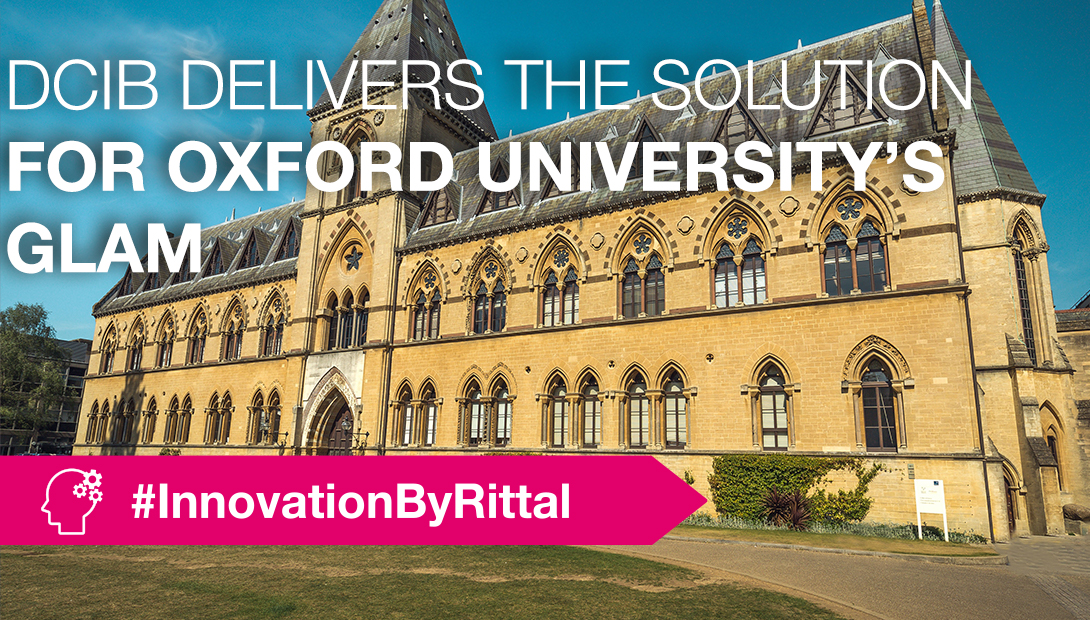
Rittal's DCiB Delivers a Sustainable IT Solution for Oxford University GLAM Division.
To enable the Museum of Natural History, to modernize its IT infrastructure by upgrading, their core network and future-proofing the reliability of its critical IT services. A major rewiring project was undertaken, to significantly improve the data connectivity, for computers, phones and next-generation devices.
Searching for a solution
The wiring presented a challenge in itself, as the historically listed building was not designed to accommodate conventional hardware. This required ingenious methods of working with the fabric of the building.
Faced with these challenges, Anjanesh Babu the technical project lead for GLAM researched the options available. Anjanesh and his team, did consider the traditional approach, of building a designated IT space. This would have resulted in the building being stripped bare and rebuilt with dedicated air conditioning and electrical infrastructure to meet the requirements of the equipment.
However given the nature and historical significance of the building, this would have presented a number of challenges, including restricted space and losses through inefficient surfaces when cooling the entire room. It was also a requirement throughout the planning phase, for the project to incorporate and consider the guidance of the GLAM Sustainability strategy.
Working in collaboration
Anjanesh Babu decided to approach, Rittal's IT team who quickly identified the “Data Centre in a Box” (DCiB) concept as the best option. DCiB replicates the key data centre capabilities, but on a smaller scale and has been developed, to enable equipment to be deployed, in non-traditional Data Centre environments. The turnkey product concept provides IT Racks, demand-orientated climate control, power distribution units, monitoring and fire suppression. Its the complete package from product selection, installation through to planned maintenance.
Following a site visit with Rittal's area sales manager Joel Farrington, a solution with the customer was agreed. It was established that the location of the DCiB would be in the museum’s basement. Access to the basement was comprised with a very narrow staircase & doorways leading into the IT room. In addition to this, the building’s listed status meant that any cooling equipment, would have to be positioned strategically and with the utmost consideration.
DCiB Installation
Joel and members of the IT development team, Clive Partridge and Andrew Wreford, worked with Anjanesh Babu to identify key areas, that needed to be achieved. Whilst taking into consideration the IT load and the environment of the proposed location, it became clear that the liquid cooling unit option, would be the best solution.
The IT Development team quickly configured a DCiB package to include a network cabinet, Zero U internally mounted cooling unit, Detac fire suppression, CMC monitoring with Power distribution units. To solve the issue of restricted access, the ‘rack splitting / re-joining’ service was used, which consisted of cutting a cabinet frame into two parts and reassembling it with the use of a joining bracket. This enables the cabinet to be easily positioned and reassembled within a confined space.
Rittal was able to provide an end-to-end solution, from the manufacture of kit, to the installation, commissioning and hand-over to the client. To overcome the issues associated with a listed building, Rittal’s IT team worked in collaboration with Anjanesh Babu and the lead contractor, to find a suitable outside space for the condenser. By adopting “in-rack” precision cooling instead of “in-room” cooling, the LCU solution has increased energy efficiency, which has had an impact on reducing operational costs, this in turn improves equipment longevity. Cooling via the high-performance LCU option provides temperature consistency along with a next to silent operation.
Looking to the future
Technical project lead from GLAM, Anjanesh Babu, reflected on the products and service provided by our team: “Rittal’s DCiB allowed the museum to utilise the proposed location without having to make costly building modifications, thus saving time, energy and effort.”
Haas Ezzet, Head of IT Gardens and Museums (GLAM) at the University of Oxford, contextualizes this piece of work as being part of the “Museum’s drive towards greater environmental sustainability. The approach piloted here of focusing climate control, specifically to the area needed the data cabinet, rather than the entire space in which it is house, will optimize energy consumption and will act as a blueprint for other spaces within GLAM and beyond.”
Check out our website for more information on DCiB and Cooling options to suite your IT infrastructure.
To learn more about our DCiB and cooling products, follow the below link to our brochure:


